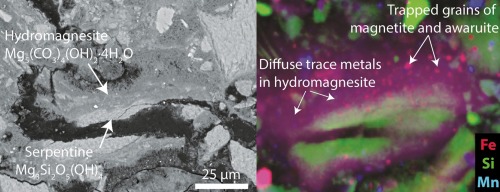International Journal of Greenhouse Gas Control ( IF 4.6 ) Pub Date : 2018-03-06 , DOI: 10.1016/j.ijggc.2018.02.008 Jessica L. Hamilton , Sasha Wilson , Bree Morgan , Connor C. Turvey , David J. Paterson , Simon M. Jowitt , Jenine McCutcheon , Gordon Southam

|
Mineral carbonation in ultramafic mine tailings is generally accepted to be a safe and long term means of trapping and storing CO2 within the structures of minerals, but it poses the risk of releasing potentially hazardous metal contaminants from mineral wastes into the environment. Stockpiles of reactive, finely pulverised ultramafic mine tailings are ideal natural laboratories for the observation and promotion of the carbonation of Mg-silicate and Mg-hydroxide waste minerals via reaction with atmospheric or industrial CO2. However, ultramafic mine tailings commonly contain first-row transition metals (e.g., Cr, Co, Cu, Ni) in potentially toxic concentrations within the crystal structures of Mg-silicates, sulphides, and oxides. These transition metals are likely to be mobilised by mineral carbonation reactions, which require mineral dissolution to supply cations for reaction with carbon. At Woodsreef Chrysotile Mine, New South Wales, Australia, transition metals (i.e., Fe, Cr, Ni, Mn, Co, Cu) are most concentrated within minor oxides (magnetite and chromite) and trace alloys (awaruite, Ni2-3Fe and wairauite, CoFe) in serpentine tailings, however, mobilisation of transition metals appears to occur predominantly during dissolution of serpentine and brucite, which are more abundant and reactive phases, respectively. Here, we present new synchrotron X-ray fluorescence mapping data that provide insights into the mobility of first-row transition metals (Fe, Cr, Ni, Mn, Co, Cu) during weathering and carbonation of ultramafic mine tailings collected from the Woodsreef Chrysotile Mine. These data indicate that the recently precipitated carbonate minerals, hydromagnesite [Mg5(CO3)4(OH)2·4H2O] and pyroaurite [Mg6Fe2(CO3)(OH)16·4H2O] sequester trace metals from the tailings at concentrations of 10 s–100 s of ppm, most likely via substitution for Mg or Fe within their crystal structures, or by the physical trapping of small (μm-scale) transition-metal-rich grains (i.e., magnetite, chromite, awaruite), which are stabilised within alkaline carbonate cements. Trace transition metals are present at relatively high concentrations in the bulk tailings (i.e., ∼0.3 wt.% NiO and Cr2O3) and they are largely retained within the unaltered mineral assemblage. The weathering products that occur at the surface of the tailings and form a cement between grains of partially dissolved gangue minerals immobilise transition metals on spatial scales of micrometres and at comparable concentrations to those observed in the unaltered tailings. The end result is that trace metals are not present at detectable levels within mine pit waters. Our observations of metal mobility during passive carbonation suggest that mineral products of accelerated carbonation treatments are likely to sequester trace metals. Thus, accelerated carbonation is unlikely to pose an environmental risk in the form of metalliferous drainage so long as the neutralisation potential of the tailings is not exceeded.
Understanding both trace transition metal geochemistry and mineralogy within materials targeted for mineral carbonation could allow optimisation of treatment processes and design for recovery of valuable metals. In ex situ reactors employing acid pre-treatments, trace metals mobilised from reactive phases such as serpentine and brucite could potentially be recovered using pH-swing methods, while recalcitrant metal-rich accessory minerals, including magnetite, awaruite and chromite, could be recovered from treated residue material by conventional mineral separation processes. Recovery of valuable metals (i.e., Ni, Cr and Co) as by-products of accelerated mineral carbonation technologies could also provide an important economic incentive to support broader adoption of this technology.
中文翻译:

在超镁铁矿尾矿通过空气捕集进行被动碳化过程中过渡金属的命运,具有回收金属资源的潜力
一般认为,超镁铁矿尾矿中的矿物碳酸化是一种在矿物结构中捕集和储存CO 2的安全且长期的方法,但存在将矿物废物中潜在的有害金属污染物释放到环境中的风险。反应性,细粉碎的超镁铁矿尾矿库存是用于观察和促进镁硅酸盐和氢氧化镁废矿物与大气或工业CO 2反应碳化的理想天然实验室。然而,超镁铁矿尾矿通常在硅酸镁,硫化物和氧化物的晶体结构中含有潜在有毒浓度的第一行过渡金属(例如Cr,Co,Cu,Ni)。这些过渡金属很可能会通过矿物碳酸化反应而动员,这需要矿物溶解才能提供阳离子以与碳反应。在澳大利亚新南威尔士州Woodsreef温石棉矿中,过渡金属(即Fe,Cr,Ni,Mn,Co,Cu)最集中于少量氧化物(磁铁矿和亚铬铁矿)和痕量合金(awaruite,Ni 2-3中)然而,蛇纹石尾矿中的铁和wairauite(CoFe),过渡金属的动员似乎主要发生在蛇纹石和水镁石的溶解过程中,这分别是较丰富的和反应性的阶段。在这里,我们介绍了新的同步加速器X射线荧光作图数据,这些数据提供了从Woodsreef温石棉收集的超镁铁矿尾矿在风化和碳化过程中第一行过渡金属(Fe,Cr,Ni,Mn,Co,Cu)的迁移性的见解。矿。这些数据表明最近沉淀的碳酸盐矿物,菱镁矿[Mg 5(CO 3)4(OH)2 ·4H 2 O]和焦铁矿[Mg 6 Fe 2(CO 3)(OH)16 ·4H 2 O]以10 s–100 s ppm的浓度螯合尾矿中的痕量金属,最有可能是通过在其晶体结构中替代Mg或Fe,或通过物理捕获小(μm级)跃迁而实现的。富含金属的晶粒(即磁铁矿,铬铁矿,磷灰石),可在碱性碳酸盐水泥中稳定。痕量过渡金属以相对较高的浓度存在于本体尾矿中(即〜0.3 wt。%NiO和Cr 2 O 3)),它们很大程度上保留在未改变的矿物组合中。出现在尾矿表面并在部分溶解的脉石矿物之间形成水泥的风化产物,将过渡金属固定在微米级的空间尺度上,其浓度可与未改变的尾矿中观察到的浓度相当。最终结果是在矿井水中不存在可检测水平的痕量金属。我们对被动碳化过程中金属迁移率的观察表明,加速碳化处理过程中的矿物质可能会隔离痕量金属。因此,只要不超过尾矿的中和潜力,加速碳酸化就不可能以含金属的排水形式带来环境风险。
了解用于矿物碳酸化的材料中的痕量过渡金属地球化学和矿物学,可以优化处理工艺和设计用于回收有价值的金属。在采用酸预处理的异位反应器中,可以利用pH摇摆法回收从反应相(如蛇纹石和水镁石)中迁移出来的痕量金属,而顽固的富含金属的辅助矿物质(包括磁铁矿,明矾和铬铁矿)可以回收。常规矿物分离工艺处理残渣材料。作为加速矿物碳酸化技术的副产品,回收有价值的金属(例如,Ni,Cr和Co)也可以提供重要的经济诱因,以支持该技术的更广泛采用。











































 京公网安备 11010802027423号
京公网安备 11010802027423号